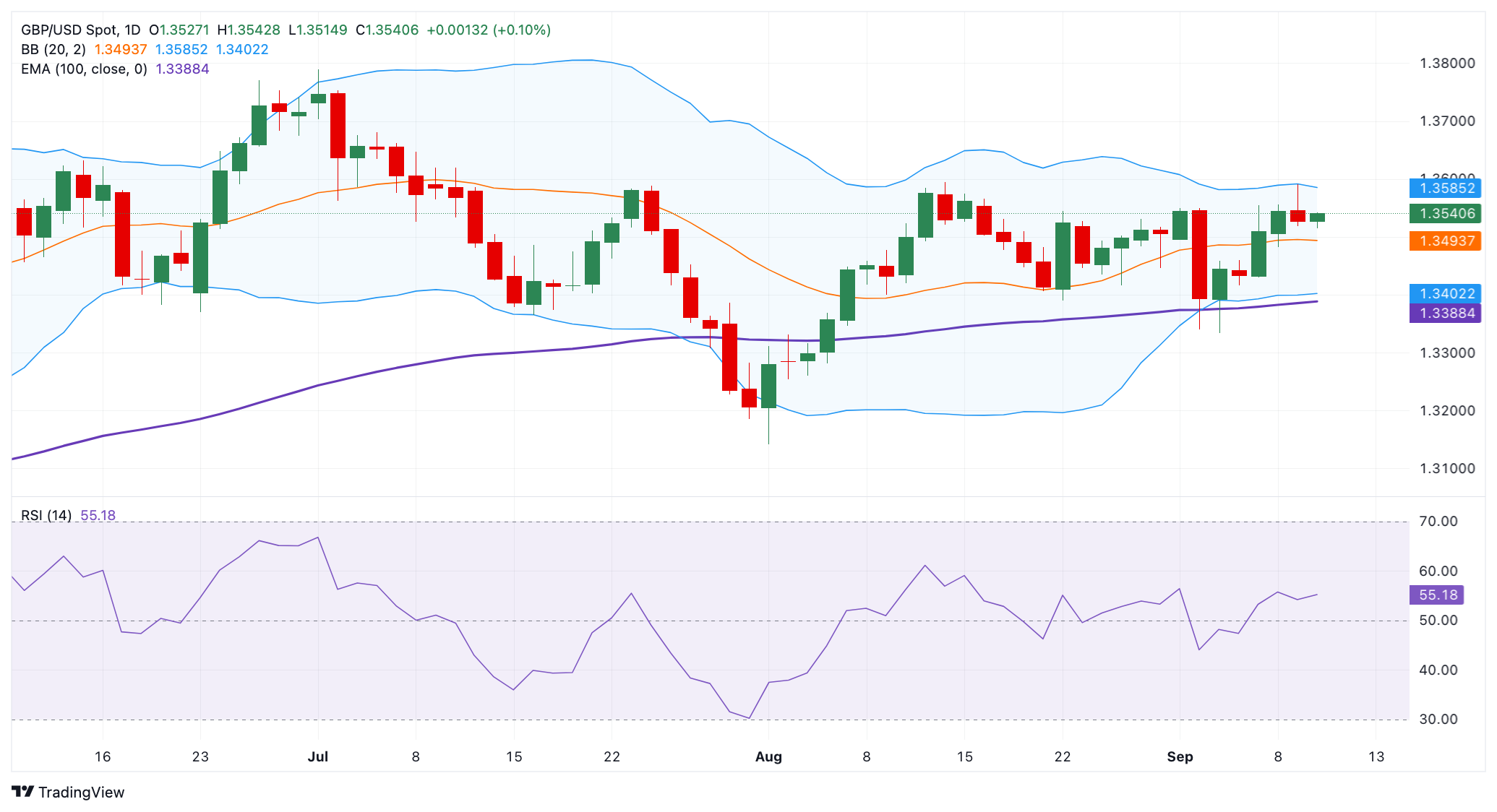GBP/USD Price Forecast: Crucial upside barrier emerges near 1.3600, traders await US PPI release

- GBP/USD strengthens to around 1.3540 in Wednesday’s early European session.
- Positive view of the pair prevails above the 100-day EMA, with a bullish RSI indicator.
- The immediate resistance level emerges in the 1.3585-1.3600 zone; the first support level to watch is 1.3496.
The GBP/USD pair trades on a stronger note around 1.3540 during the early European session on Wednesday. Traders ramp up their bets that the US Federal Reserve (Fed) will lower the borrowing costs at its September 16-17 policy meeting, which weighs on the US Dollar (USD) against the Cable. Traders await the US August Producer Price Index (PPI) data later on Wednesday, as it could help define the size and scope of interest rate cuts from the US central bank for next week and beyond.
Technically, the constructive outlook of GBP/USD remains in place as the major pair is well-supported above the key 100-day Exponential Moving Average (EMA) on the daily chart. Additionally, further upside looks favorable, with the 14-day Relative Strength Index (RSI) standing above the midline near 66.50. This displays the bullish momentum in the near term.
The key upside barrier emerges in the 1.3585-1.3600 zone, representing the upper boundary of the Bollinger Band, the high of September 9, and a psychological level. A decisive break above this level could pick up more momentum and aim for 1.3632, the high of June 13. Further north, the next resistance level is seen at 1.3752, the high of July 2.
On the downside, the low of September 1 at 1.3496 acts as an initial support level for GBP/USD. A breach of this level could drag the major pair toward the lower limit of the Bollinger Band of 1.3400. The next contention level to watch is 1.3388, the 100-day EMA.
GBP/USD daily chart

Pound Sterling FAQs
The Pound Sterling (GBP) is the oldest currency in the world (886 AD) and the official currency of the United Kingdom. It is the fourth most traded unit for foreign exchange (FX) in the world, accounting for 12% of all transactions, averaging $630 billion a day, according to 2022 data. Its key trading pairs are GBP/USD, also known as ‘Cable’, which accounts for 11% of FX, GBP/JPY, or the ‘Dragon’ as it is known by traders (3%), and EUR/GBP (2%). The Pound Sterling is issued by the Bank of England (BoE).
The single most important factor influencing the value of the Pound Sterling is monetary policy decided by the Bank of England. The BoE bases its decisions on whether it has achieved its primary goal of “price stability” – a steady inflation rate of around 2%. Its primary tool for achieving this is the adjustment of interest rates. When inflation is too high, the BoE will try to rein it in by raising interest rates, making it more expensive for people and businesses to access credit. This is generally positive for GBP, as higher interest rates make the UK a more attractive place for global investors to park their money. When inflation falls too low it is a sign economic growth is slowing. In this scenario, the BoE will consider lowering interest rates to cheapen credit so businesses will borrow more to invest in growth-generating projects.
Data releases gauge the health of the economy and can impact the value of the Pound Sterling. Indicators such as GDP, Manufacturing and Services PMIs, and employment can all influence the direction of the GBP. A strong economy is good for Sterling. Not only does it attract more foreign investment but it may encourage the BoE to put up interest rates, which will directly strengthen GBP. Otherwise, if economic data is weak, the Pound Sterling is likely to fall.
Another significant data release for the Pound Sterling is the Trade Balance. This indicator measures the difference between what a country earns from its exports and what it spends on imports over a given period. If a country produces highly sought-after exports, its currency will benefit purely from the extra demand created from foreign buyers seeking to purchase these goods. Therefore, a positive net Trade Balance strengthens a currency and vice versa for a negative balance.







